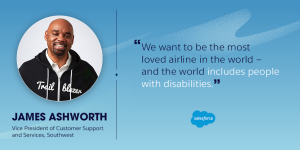When Southwest Airlines hit the stock market in 1977, it chose the ticker symbol LUV. From the outside, it may seem an incongruous choice — but to employees then and now, it’s a natural fit.
“We want to be the most loved airline in the world,” says James Ashworth, Southwest Vice President of Customer Support and Services. “And the world includes people with disabilities.”
Most companies today understand that accessibility is good business; Accenture has reported how companies that embrace best practices for employing and supporting more persons with disabilities have outperformed their peers. But not every company goes to the lengths Southwest does to deliver accessible experiences to customers and employees alike. [Click to Tweet]
It’s estimated that one-quarter of U.S. adults are living with a disability. In Southwest’s customer service contact centers, roughly one in 10 employees use accessibility tools.
That’s one reason the Southwest Customer Support and Service team deployed Salesforce Service Cloud. By providing an accessible way for representatives and customers to communicate without barriers, Service Cloud empowers Southwest’s employees to deliver exceptional customer experiences. “It’s about letting technology do what technology does best,” says Erica Tyler, Southwest’s Director of Business Strategy, “so that humans can do what humans do best — connect and help each other.”
A level playing field
Eric Aiken, a Customer Service and Support Representative who is visually impaired, recalls that Southwest founder Herb Kelleher was one of those rare bosses who saw his employees not just as workers, but as people. “It didn’t matter who you were — he knew you by name. And our leaders continue to show their love to us by making our environment easy to work in. Because of that, we’re able to offer great customer service to our passengers and make them feel loved as well. I think it goes both ways.”
According to Salesforce research, employees who feel a sense of belonging at work are more than five times more likely to perform better than those who don’t. According to Tyler, the executive team at Southwest gets this. “Which is why accessibility is important for us. We have an inclusive environment and we want to offer the same opportunities to all our employees. Whether you’re hearing impaired or visually impaired, Service Cloud opens up more opportunities to engage with our customers.”
Service Cloud works with screen readers, has a robust set of keyboard shortcuts, and high-color contrast so that employees who are visually impaired can easily navigate the Lightning Service Console. Before Salesforce, customer service interactions could require Southwest reps to use up to 15 different tools to gather a customer’s data. “Sometimes those tools could be kind of cumbersome, especially for somebody that’s visually impaired like me,” Aiken remembers. This accessible, 360-degree customer view means agents like Aiken can spend less time navigating tools and more time improving the customer experience.
Keeping the LUV, at scale
When the first Southwest plane took to the sky in 1971, the airliner served three locations. Today, more than 4,000 Southwest flights travel through American and international skies every day. As the company grows, its 1.3 million customers expect more personalized service than ever before. So how does Southwest make it work?
“Consumer expectations are continuously expanding,” explains Tyler. “As we continue to scale, we don’t want to lose the personal interaction. And that’s pushing us to grow our capabilities so that we can meet our customers where they are, on the channels that they prefer to engage in.”
With Service Cloud’s accessible chat functionality, Southwest’s reps can offer that same quality of service to hearing and visually impaired customers.
“A really nice surprise after rolling out the Salesforce chat functionality was feedback from those who are hearing impaired,” says Tyler. “They were just really excited about this new way to engage. We heard from a family — the entire family was hearing impaired — and they just wanted to tell us how pleased they were that we offered this channel. They felt more of a connection with Southwest.”
“As someone who’s visually impaired and using accessibility tools in my personal and professional life, I knew we needed a partner who was as passionate about accessibility as we were,” says Ashworth. “I believe that Southwest Airlines and Salesforce share DNA, because our cultures are alike in a whole lot of ways.”
Inclusion by design
Southwest’s leaders understand that there’s no better way to accommodate customers with disabilities than by talking to employees with disabilities. That’s why Ashworth invited frontline reps to help customize Service Cloud to their needs.
“That’s what I admire most about the tool — it’s configurable. So an employee might say, ‘Hey, I’d like the information in the top left-hand corner here’ or ‘I’d like a certain dataset over in the bottom corner.’” Representatives who are sighted and visually impaired both participate in the beta testing stage of implementation — at Southwest, accessibility is not an afterthought.
“It’s about our people being able to drive what the service console looks like for them,” Ashworth explains. “It’s about a diverse group of employees sitting down with us at headquarters and really telling us what they want their experience with this tool set to look like. If our employees feel confident that we listen to them, they feel more confident and empowered to deliver the right type of customer experience.”
Ashworth knows that as Southwest reps change how they work, the tool can innovate with them. “We’ll continue to let our employees guide what Service Cloud looks like.”
For more Service Cloud innovations, see the announcement about voice technology.



















